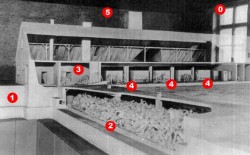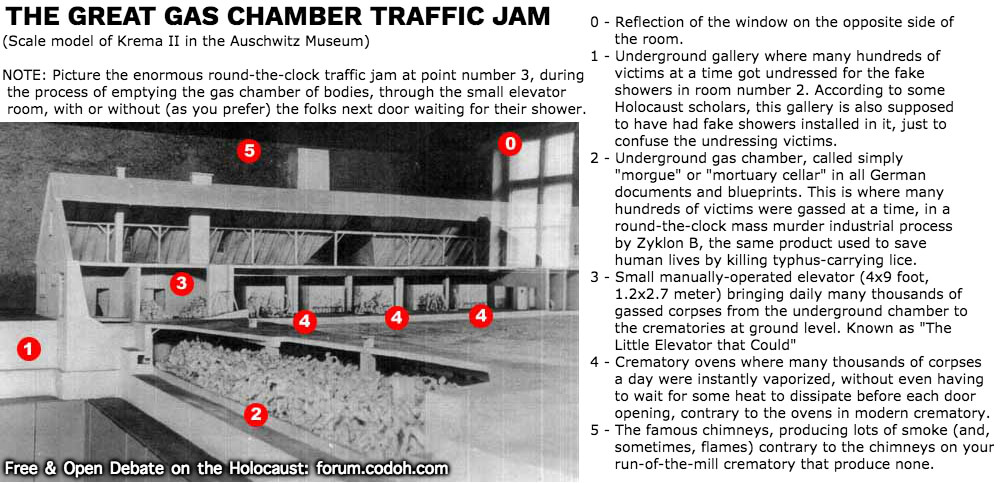Strike 1:The absurdity of 'Gas Chambers' being washed down after each gassing is addressed here:
R.Muehlenkamp: 'gas chambers' were hosed down, so no cyanide
viewtopic.php?t=3706Why They Could Not Have Hosed Down The Gas Chambers
viewtopic.php?t=3332Those Prussian Blues Just Won't Wash
viewtopic.php?t=4600Please note that the majority of supposed "eyewitness testimony of mass gassings" at Auschwitz make no mention of this washing-down of the walls. "Eyewitness" Daniel Bennahmias claims the Nazis not only hosed down the gas chambers, but repainted the walls after each gassing...
 Strike 2:
Strike 2:Germar Rudolf addresses the cyanide penetration claim:
1. It is a fact that the walls of the disinfestation chambers in Auschwitz, Birkenau, Stutthof, and Majdanek are saturated with cyanide compounds, and this not only superficially, but into the depth of the masonry, as I have proved by taking samples from different depths of the wall, compare in this regard especially my samples no. 11, 13, 17, 19b, and 23. They prove that hydrogen cyanide can rather easily reach deep layers of plaster and mortar. But even the other samples taken from the surface prove that Prof. Roth's allegation is wrong: Provided that most of the cyanide detectable today is present in the form of iron cyanide (Iron Blue and other cyanoferrates), as Prof. Roth assumes himself, his thesis would mean that 10% to 75% of the iron content of these samples are located in the upper 10 micrometer of my samples (0.010 mm), i.e., they are located in less then 1% of the entire sample mass, and the rest of the sample would have been massively deprived of iron. How this migration of a major portion of iron to a thin surface layer would have happened is inexplicable to me.
2. Furthermore, expert literature is detailed in that
a. hydrogen cyanide is a extremely mobile chemical compound with physical properties comparable to water,[159]
b. which can quite easily penetrate through thick, porous layers like walls.[98]
3. In addition, it is generally known that cement and lime mortar are highly porous materials, comparable for instance with sponges.[160] In such materials, there does not exist something like a defined layer of 0.01 mm beyond which hydrogen cyanide could not diffuse, as there can also be no reason, why water could not penetrate a sponge deeper than a millimeter. Steam, for example, which behaves physically comparable to hydrogen cyanide, can very easily penetrate walls.
4. Finally, the massive discolorations of the outside walls of the disinfestation chambers in Birkenau and Stutthof, as shown on the cover of this book, are clearly visible and conclusive evidence for the fact how easily hydrogen cyanide and its soluble derivatives can penetrate such walls.
Some Technical and Chemical Considerations about the 'Gas Chambers' of Auschwitz and Birkenau
https://codoh.com/library/document/925/Strike 3:The "Institute for forensic research in Krakow" Report is reproduced here, along with a rebuttal:
An Official Polish Report on the Auschwitz 'Gas Chambers' - Krakow Forensic Institute Confirms Leuchter's Findings
https://codoh.com/library/document/2333/It is also important to note that the claim Myles makes "they extracted iron cyanide based compounds from the walls" is incorrect. They specifically ignored Prussian Blue and similar iron cyanide compounds from their analysis, focusing only on non-iron cyanide compounds to get a value very close to the detection level. Basically their results were not significant for any sample.
Germar Rudolf explains this in detail, totally debunking the psuedoscientific Krakow/Polish report here:
Germar Rudolf wrote:It is more than twelve years ago that an American technician went to Auschwitz concentration camp and made the first forensic research ever conducted by an independent researcher. His expert report triggered a broad and sometimes heated debate, as it was not in line with the generally excepted view held about Auschwitz. Under such circumstances one would expect that many scholars would get involved in this matter trying to refute Leuchter’s thesis. But in all these years only one scientific paper has been published in a fairly unknown Polish journal addressing the chemical questions raised by Leuchter. However, the Polish authors of this work did such a sloppy job that their attempt to refute Leuchter not only fails but calls into question their scientific credentials. Furthermore, it will be demonstrated that the unscientific methodology applied by these Poles can only be called fraudulent. Under normal circumstances, these Polish authors would be expelled from the scientific community for their unethical behavior.
...
The Poles ignored all arguments proving them wrong, though they definitively knew them, since they quoted them. They did nothing to verify or falsify their own claims. They did nothing to understand what they claimed to not having understood. But why did they act that way?
The answer to that is very easy: They wanted to exclude the Prussian Blue and similar iron cyanide compounds from their analyses. This can only be justified when assuming that Prussian Blue in the walls of the delousing chambers must have a different origin, e.g. stemming from paint. They themselves wrote:
"We decided therefore to determine the cyanide ions using a method that does not induce the breakdown of the composed ferrum cyanide complex (this is the blue under discussion)[…]"
What does that mean?
Fact is: The exclusion of Prussian Blue from analytical detection must result in much lower analyses results for the delousing chambers, as non-iron cyanide compounds are not very stable and would therefore hardly be present after 50 years. The same is true for every room ever exposed to hydrogen cyanide. In fact, values close to the detection level must be expected, which are generally so unreliable, that a proper interpretation is close to impossible. It can therefore be expected that the analysis of samples tested with such a method would deliver similar results for nearly every sample of material that is many decades old. Such an analysis would make it rather impossible to distinguish between rooms massively exposed to hydrogen cyanide and those, which were not.
And that is in my opinion exactly what the Poles wanted to achieve: Values for both the delousing chambers and the alleged homicidal gas chambers with similar levels of cyanide residues. This would allow them to state: ‘See: same amount of cyanides, hence same amount of gassing activity, thus humans were gassed in the gas chambers. Henceforth, Leuchter is refuted.’
As a matter of fact, that is exactly what the analyses results of the Poles delivered, and they concluded accordingly.
...
5. Conclusions
Let me summarize the extremely unscientific and politically biased approach of Markiewicz and his co-workers:
a. The most important task of a scientist is to try to understand what hasn’t been understood so far. The Poles just did the opposite: they decided to ignore and exclude what they didn’t understand (the formation of Prussian Blue in walls exposed to hydrogen cyanide).
b. The next important task of a scientist is to discuss other scientists’ attempts to make understandable. The Poles just did the opposite: they decided to ignore and exclude from discussion what would perhaps make them (and others) understand how Prussian Blue can be formed.
c. That allowed them to use methods producing the results they wanted to see.
d. They suppressed results that didn’t fit into their desired results.
e. Finally, they admitted that the purpose of their research was not to seek the truth, but to keep totally discredited the reputation of one, who has long since rotted away.
Hence, I publicly called and still call these Polish authors scientific frauds. Neither Markiewicz nor his co-workers ever stood up against that accusation. Dr. Markiewicz died in 1997, and the remaining two co-authors have been silent about that ever since, like thieves hiding in the night.
A fraudulent attempt to refute Mr. Death
http://vho.org/GB/c/GR/Fraudulent.htmlBasically, these liars did exactly what Myles accused Leuchter of doing: "design[ing] experiments to get the results they wanted" and "stacked the deck in their favor" ... talk about ironic
 Anyway, what comes after strike 3?
Anyway, what comes after strike 3? 
It is simply dishonest of Myles to focus so heavily on the Leuchter report, while totally ignoring the Rudolf Report. I am not sure how this guy could have done his research and not come across the Rudolf Report; he must simply be fishing for likes and YouTube ad revenue...
The Rudolf Report: Expert Report on Chemical and Technical Aspects of the ‘Gas Chambers’ of Auschwitz
http://www.vho.org/GB/Books/trr/






